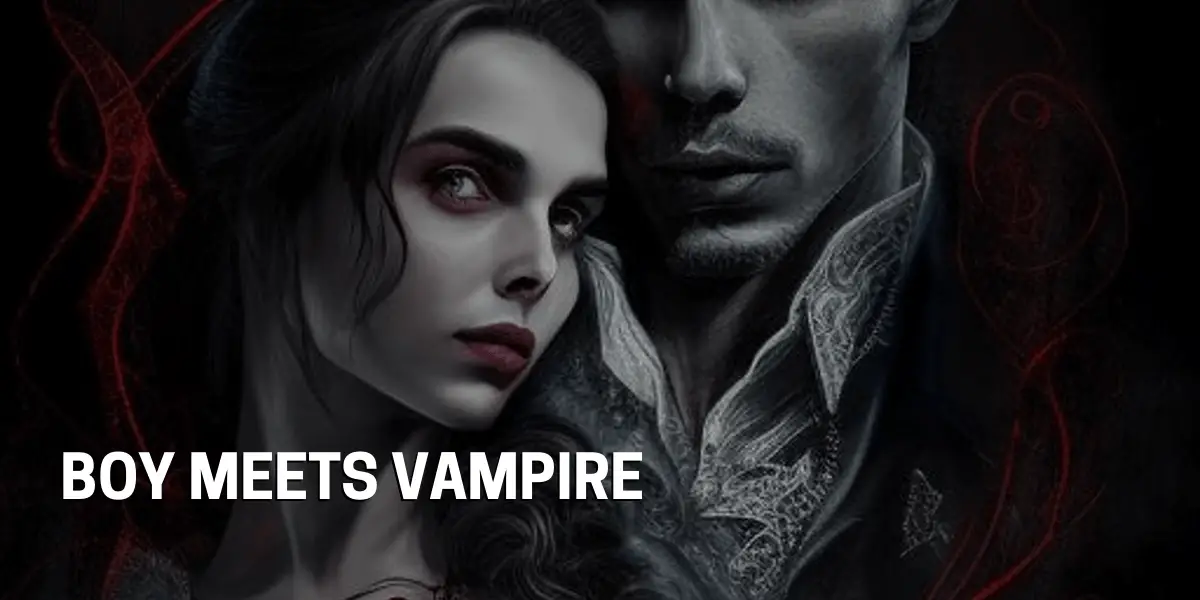Boy Encountering Vampire
Many horror stories have been told about such encounters and the consequences can be dire. However, it is important to understand the context behind such encounters and the intentions of the vampire.
It is believed that vampires often seek out young boys for their innocence, energy, and naivety. Vampires may be drawn to the boy’s energy and view them as an easy target. It is also possible that the vampire is simply looking for company and wants to form a bond with the boy.
When a young boy is confronted by a vampire, it can be a terrifying experience. The boy may be frightened and confused, unsure how to respond. It is important for a young boy to not panic and to remain calm and collected. Being brave and confident, even if the boy is scared, is key.
It can be helpful to try and establish a dialogue with the vampire and to understand their intentions. The consequences of a boy interacting with a vampire can be severe. Depending on the vampire’s intentions, the boy could be put in danger.
If the vampire is looking for a companion, the boy could be put in a difficult situation and may find themselves in a vulnerable state. It is important for the boy to be aware of the risks involved and to take necessary precautions.

Background of Vampire
In recent years, the myth of the vampire has captivated our imaginations. For centuries, people have crafted stories and tales of these creatures, exploring their origins and interpretations. Vampires have their roots in early European folklore and mythology, with tales often depicting them as undead creatures that feed on the blood of the living. Traditional beliefs have portrayed them as powerful, immortal and mysterious beings, with a thirst for blood and an aversion to daylight.
Over time, the image of the vampire has shifted and evolved, from the classic depiction of a vampire as a monster to a more sympathetic creature. The popularity of vampires has also been reflected in popular culture, literature and films. From Bram Stoker’s classic novel Dracula to the Twilight series, stories about vampires have been thrilling audiences for decades. They have also been featured in various TV shows, films and video games.
More recently, modern interpretations of the vampire myth have taken center stage. Some stories have reimagined the vampire as a romantic and heroic figure, while others have presented them as a more sinister and evil creature. These interpretations have sought to redefine the vampire myth and explore the nuances of this mysterious creature.
Types of Vampires
A deep dive into the world of vampires reveals a variety of different types of vampires that exist in literature and film. From traditional vampires to modern interpretations, each version of the classic creature has its own unique characteristics and traits. Classic vampires are often portrayed as having pale skin, sharp teeth, and an unquenchable thirst for human blood. Modern vampires, on the other hand, are often depicted in a more human-like form, and are often seen engaging in day jobs and forming relationships with humans.
In addition, there are various sub-classes of vampires, such as werewolves and succubi, that have their own unique characteristics. With each interpretation of the vampire myth, our understanding of the creature deepens and evolves.
Vampire Motives
Vampires have been a part of folklore and literature for centuries, and it is no surprise that they have captivated our imaginations. But why do vampires seek out young boys in particular? It turns out that there are several reasons why vampires might be drawn to young boys. First and foremost is the need for sustenance; vampires must feed on blood to survive, and young boys are an easy target.
Power is another common reason, as vampires can use their abilities to manipulate and control their victims. Finally, vampires may simply seek out companionship and even form relationships with young boys.
Survival
Knowing the strength and weaknesses of vampires is key to survival. It is essential to have garlic and crosses on hand for a potential confrontation. Having a strategy in place is also important for survival. Being aware of the vampire’s movements and the environment is crucial to ensuring a safe outcome.
It is not enough to be aware of the risks, however. Taking necessary precautions is an absolute must. Being prepared is the only way to guarantee a safe outcome in any confrontation with a vampire.

Power
How young boys often come face-to-face with vampires is a frightening reality. Vampires have immense power, and boys must find a way to overcome their strength.
To do so, boys must call upon their own courage and strength, and use their wits to strategize and survive. With careful planning and clever tactics, boys can eventually triumph over the vampire.
Gaining confidence and power in the process, this victorious outcome does not come without consequences. Far-reaching and possibly lasting and damaging effects are the results of such an encounter.
Consequences of Encounter
We all know of the legendary creatures of the night – vampires. But what happens when a young boy comes face-to-face with one?
It can be a harrowing experience, with consequences that can be dire, depending on the vampire’s intent. If the vampire intends to harm the boy, then the boy is at physical risk.
Even if the vampire does not intend to harm the boy, the psychological impact of the experience can be immense. The encounter can leave the boy with psychological trauma or even a fear of the unknown.
The outcome of such an encounter is unpredictable, as it is impossible to know what the vampire’s intentions are.
Physical
When a young boy interacts with a vampire, the physicality of the interaction can vary greatly from case to case. In some instances, the vampire may adopt a menacing posture and the boy may take a step back. Alternatively, the vampire may be more welcoming and the boy may take a step closer.
Body language can reveal a lot about the vampire’s intentions and the boy’s apprehensions. The boy may remain very still, almost as if in a state of shock, or he may show more signs of discomfort, such as wringing his hands, shifting his weight, or averting his gaze.
Movement is also an important factor in the interaction. Does the boy move closer or further away from the vampire as the conversation progresses? This can also indicate the boy’s feelings and the vampire’s intentions.
Lastly, there is the question of touch. Does the boy touch the vampire, or does the vampire touch the boy? This can be a crucial aspect of the interaction, and it can be especially telling of the vampire’s intentions.
Psychological
When a boy meets a vampire, they can represent a variety of psychological dynamics. On the one hand, the boy could be seen as a young, curious individual seeking to explore the unknown. On the other hand, the vampire may symbolize a sense of fear and danger.
At times, the vampire could even be seen as a representation of forbidden desires, as the boy is irresistibly drawn to the mysterious and unknown. In this way, the relationship between boy and vampire can be used as a metaphor for the classic struggle between good and evil, with the boy representing the forces of good and the vampire representing the forces of darkness.

Examples of Boy Encountering Vampire
Popular stories that feature a boy encountering a vampire often include themes of adventure, exploration, and curiosity. From “Interview with the Vampire” to “The Vampire Diaries,” these stories typically feature a young protagonist who is drawn to the mysterious and unknown. In some cases, the boy may even be seen as a representation of innocence, as he is unaware of the potential danger posed by the vampire.
Movies that feature a boy encountering a vampire typically focus on the conflict between good and evil. In films like “Blade,” “Let the Right One In,” and “The Lost Boys,” the boy is seen as an innocent who must face the dangers of the vampire. In other films, like “Twilight” and “Bram Stoker’s Dracula,” the conflict is less intense, as the boy is more of an observer.
Video games that feature a boy encountering a vampire are often based on popular stories or films. “Castlevania” and “Legacy of Kain” both feature a boy as the hero who must battle a vampire. In “Castlevania,” the protagonist is a vampire hunter tasked with destroying Dracula, while in “Legacy of Kain,” the boy must save Nosgoth from the vampires who have taken control.
Buffy the Vampire Slayer
We all know the classic story of a boy encountering a vampire. But Buffy the Vampire Slayer has added a unique spin to the trope. Buffy Summers is a young girl who is tasked with fighting the vampires and other supernatural forces. Produced by Joss Whedon, the show ran for seven seasons from 1997-2003 and quickly became a pop culture phenomenon. It has been credited with influencing later supernatural shows like True Blood and The Vampire Diaries. The show has spawned comic books, novels, video games, and a spin-off series, Angel. The success of Buffy the Vampire Slayer has shown that the classic story of a boy encountering a vampire can take on new life when reimagined with a female protagonist.
The Twilight Saga
How could anyone forget the iconic story of vampire and human interaction? The Twilight Saga has become one of the most popular book series of all time, with five blockbuster films adapted from the books. It follows the story of Bella Swan, a teenage human girl, and her perilous relationship with Edward Cullen, a vampire.
The Twilight Saga explores themes of love, power, and the consequences of crossing boundaries between two distinct species. It has been both praised and criticized for its depiction of teenage romance and the potential danger of becoming involved with a vampire.
We can see similar themes explored in other popular books and shows such as Buffy the Vampire Slayer and The Vampire Diaries.
The Vampire Diaries
The Vampire Diaries is one of the most popular supernatural television series of the modern era, depicting the life of a young man and his experiences in a world of vampires and other supernatural creatures.
The show explores themes of love, family, and morality as the protagonist navigates the complex web of vampire-human relationships. Since its premiere in 2009, The Vampire Diaries has become one of the most watched television shows in history and has spawned two spin-off series, The Originals and Legacies.
These series continue to explore the lives of vampires, werewolves, and other supernatural creatures. Through its engaging story lines and captivating characters, The Vampire Diaries has captivated audiences and become an iconic part of popular culture.
Conclusion
The answer to this question is uncertain. It is possible that the vampire will be defeated and the boy will be able to remain safe from the vampire’s grasp. However, it is also possible that the vampire will remain at large, continuing to hunt for his next victim.
The encounter between the boy and vampire could also shape the boy’s future in unforeseen ways. We can only wait and see what the future holds in store.
FAQs
What is the history of vampires?
When it comes to vampires, there is a rich history behind them. For centuries, they have been a part of folklore and mythology all over the world. Vampires have been portrayed in literature, television, and movies in a multitude of ways, from the romanticized versions of the past to the modern, Gothic horror interpretations. The modern vampire has its roots in the 19th century and is often associated with the Gothic horror genre. From Bram Stoker’s Dracula to the Twilight series, vampires have been a part of popular culture for decades.
The mythology and lore surrounding these creatures has captivated audiences for generations. Yet, there are still many unanswered questions about vampires, from their origins to the different types of vampires that exist. The answer to these questions may remain a mystery, or it may be revealed in time.
What are the different types of vampires?
When it comes to vampires, there is a wealth of lore and mythology to explore. From the classic vampire, often portrayed as an aristocratic figure with supernatural powers and a thirst for blood, to the more recent vampire, often depicted as a brooding, mysterious figure with an aversion to sunlight, the many different types of vampires continue to captivate audiences.
The modern vampire is often seen as a young, rebellious figure with the power to transform and superhuman strength. These powerful creatures have been a part of popular culture for decades, from Bram Stoker’s Dracula to the Twilight series.
But what are the motives of these creatures? What drives them to exist in the shadows and to feed on the living? The possibilities are endless and the truth may never be fully revealed.
What are the motives of vampires?
Vampires have always been a source of fascination for many. From Bram Stoker’s iconic Dracula to the Twilight series, these creatures have been a part of popular culture for decades. But what motivates these creatures? What drives them to exist in the shadows and feed on the living? Research suggests that vampires are typically motivated by a need for survival, often in the form of blood or other forms of sustenance.
In some cases, they may be motivated by a desire for revenge on those who have wronged them, or a need for power or control. In other cases, the motives may remain a mystery. Whatever the reason, it is clear that the fascination with vampires will continue to endure.
But what are the consequences of a boy coming across a vampire? Could it be a chance to learn more about the dark side of life? Or could it be a terrifying and deadly experience?
What are the consequences of a boy encountering a vampire?
When a young boy encounters a vampire, the consequences can be far-reaching and unpredictable. It is a life-changing experience that can have both positive and negative effects, for example, a boy may gain knowledge or understanding of the world that he would not have known before. On the other hand, a boy may be put in danger by the vampire and find himself in a vulnerable position.
The risks associated with encountering a vampire can be physical, psychological, and supernatural. Physically, a boy may be at risk of being attacked or drained of his blood. Psychologically, a boy may experience fear, confusion, and anxiety. Supernaturally, a boy may find himself in a situation where he is unable to control what is happening around him.
The challenges that come with a vampire encounter are often difficult to manage. A boy may find himself in a situation where he is unable to protect himself, or where he is forced to make difficult decisions. He may also find himself in a situation where his actions have serious and far-reaching consequences.
v. What are some examples of a boy encountering a vampire?
Encounters with vampires can be a thrilling and unforgettable experience for a young boy. It’s a chance to explore the unknown and face it without hesitation. Walking through a graveyard at night, for example, can be a daunting task, but it can also be a journey of self-discovery. Inviting a boy to a vampire’s castle by a mysterious figure brings a sense of excitement, but it also brings a certain level of fear. What secrets lurk behind the castle walls? A boy may find himself in a dark alley where a vampire is lurking in the shadows, ready to make their move. It can be a scary and intimidating situation, but it can also be a chance to learn more about the unknown.

